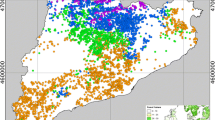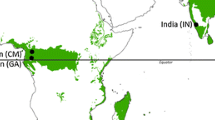Abstract
The relationship between stem surface area and stand density was analyzed using a large data set collected from 14 districts for Japanese cedar (Cryptomeria japonica D. Don) and 11 districts for Japanese cypress (Chamaecyparis obtusa Endl.) stands across Japan. The results demonstrated that the mean stem surface area in overcrowded stands was inversely proportional to the stand density for both species and all districts. The inverse relationship indicates that the total stem surface area in overcrowded stands becomes a maximum constant independent of stand density, which is termed the ‘conservation rule of stem surface area.’ Since the stem surface area is proportional to the amount of cambium cells in the stem, the conservation rule suggests that there is an upper limit to the total amount of cambium per unit area, i.e., conservation rule of cambium. The conservation rule of stem surface area was linked to the 3/2 power law of self-thinning by an allometric power exponent between stem surface area and volume. Since the allometric power exponent was approximately equal to 3/2, the self-thinning exponent would vary within a relatively narrow band around −3/2. In conclusion, we hypothesized that the conservation rule of stem surface area, or the conservation rule of cambium, may be an alternative starting point for understanding self-thinning in overcrowded tree populations.




Similar content being viewed by others
References
Bi H (2004) Stochastic frontier analysis of a classic self-thinning experiment. Austral Ecol 29:408–417
Carron LC (1968) An outline of forest mensuration with special reference to Australia. Australian National University Press, Canberra
Drew TJ, Flewelling JW (1977) Some recent Japanese theories of yield-density relationships and their application to monterey pine plantations. For Sci 23:517–534
Fang J-Y, Wang GG, Liu G-H, Xu S-L (1998) Forest biomass of China: an estimate based on the biomass-volume relationship. Ecol Appl 8:1084–1091
Fukuda M, Iehara T, Mastumoto M (2003) Carbon stock estimates for sugi and hinoki forests in Japan. For Ecol Manag 184:1–16
Gavrikov VL (2014) A simple theory to link bole surface area, stem density and average tree dimensions in a forest stand. Eur J For Res 133:1087–1094
Givnish TJ (1986) Biomechanical constraints on self-thinning in plant population. J Theor Biol 119:139–146
Hutchings M (1983) Ecology’s law in search of a theory. New Sci 16:765–767
Inoue A (2004) Relationships of stem surface area to other stem dimensions for Japanese cedar (Cryptomeria japonica D. Don) and Japanese cypress (Chamaecyparis obtusa Endl.) trees. J For Res 9:45–50
Inoue A (2009) Allometric model of the maximum size-density relationship between stem surface area and stand density. J For Res 14:268–275
Jack SB, Long JN (1996) Linkages between silviculture and ecology: an analysis of density management diagrams. For Ecol Manag 86:205–220
Kinerson RS (1975) Relationship between plant surface area and respiration in loblolly pine. J Appl Ecol 12:965–971
Lexen B (1943) Bole area as an expression of growing stock. J For 41:883–885
Long JN, Smith FW (1984) Relation between size and density in developing stands: a description and possible mechanisms. For Ecol Manag 7:191–206
Niklas KJ (1994) Plant allometry: the scaling of form and process. University of Chicago Press, Chicago
Nishizono T, Tanaka K (2012) Does the relationship between quadratic mean diameter and stem density in old thinned and unthinned Cryptomeria japonica forests deviate from a power function? J For Plan 18:63–76
Ogawa K, Hagihara A (2003) Self-thinning and size variation in a sugi (Cryptomeria japonica D. Don) plantation. For Ecol Manag 174:413–421
Oohata S, Shidei T (1974) A study on the annual change of net productivity in the forest communities. Bull Kyoto Univ For 46:40–50 (in Japanese with English summary)
Osawa A (1995) Inverse relationship of crown fractal dimension to self-thinning exponent of tree populations: a hypothesis. Can J For Res 25:1608–1617
Osawa A, Allen RB (1993) Allometric theory explains self-thinning relationships of mountain beech and red pine. Ecology 74:1020–1032
Osawa A, Kurachi N (2004) Spatial leaf distribution and self-thinning exponent of Pinus banksiana and Populus tremuloides. Trees 18:327–338
Osawa A, Sugita S (1989) The self-thinning rule: another interpretation of Weller’s results. Ecology 70:279–283
Pretzsch H (2005) Stand density and growth of Norway spruce (Picea abies (L.) Karst.) and European beech (Fagus sylvatica L.): evidence from long-term experimental plots. Eur J For Res 124:193–205
R Development Core Team (2014) The R project for statistical computing. http://www.R-project.org. Accessed 25 Dec 2014
Solomon DS, Zhang L (2002) Maximum size-density relationships for mixed softwoods in the northeastern USA. For Ecol Manag 155:163–170
Sun H, Zhang J, Duan A, He C (2011) Estimation of the self-thinning boundary line within even-aged Chinese fir (Cunninghamia lanceolata (Lamb.) Hook.) stands: onset of self-thinning. For Ecol Manag 261:1010–1015
Weiskittel A, Gound P, Temesgen H (2009) Source of variation in the self-thinning boundary line for three species with varying levels of shade tolerance. For Sci 55:84–93
Weller DE (1987a) A reevaluation of the −3/2 power rule of plant self-thinning. Ecol Monogr 57:23–43
Weller DE (1987b) Self-thinning exponent correlated with allometric measures of plant geometry. Ecology 68:813–821
Weller DE (1990) Will the real self-thinning rule please up? A reply to Osawa and Sugita. Ecology 71:1204–1207
West GB, Brown JH, Enquist BJ (1997) A general model for the origin of allometric scaling laws in biology. Science 276:122–126
Westoby M (1984) The self-thinning rule. Adv Ecol Res 14:167–225
White J, Harper JL (1970) Correlated change in plant size and number in plant populations. J Ecol 58:467–485
Xue L, Ogawa K, Hagihara A, Liang S, Bai J (1999) Self-thinning exponents based on the allometric model in Chinese pine (Pinus tabulaeformis Carr.) and Prince Rupprecht’s larch (Larix principis-rupprechtii Mayr) stands. For Ecol Manag 117:87–93
Yoda K, Kira T, Ogawa H, Hozumi K (1963) Self-thinning in overcrowded pure stands under cultivated and natural conditions. J Biol Osaka City Univ 14:107–129
Zhang L, Bi H, Gove JH, Heath LS (2005) A comparison of alternative methods for estimating the self-thinning boundary line. Can J For Res 35:1507–1514
Zhang J, Oliver WW, Powers RF (2013) Reevaluating the self-thinning boundary line for ponderosa pine (Pinus ponderosa) forest. Can J For Res 43:963–971
Zianis D, Muukkonen P, Mäkipää R, Mencussini M (2005) Biomass and stem volume equations for tree species in Europe. Silva Fenn Monogr 4:1–63
Acknowledgments
Thanks are due to the Forestry and Forest Products Research Institute for publishing the large data set used in the present study. The authors wish to sincerely thank two anonymous reviewers for their valuable and insightful comments. A.I. was funded by KAKENHI (24780155).
Author information
Authors and Affiliations
Corresponding author
Additional information
Communicated by Rainer Matyssek.
Rights and permissions
About this article
Cite this article
Inoue, A., Nishizono, T. Conservation rule of stem surface area: a hypothesis. Eur J Forest Res 134, 599–608 (2015). https://doi.org/10.1007/s10342-015-0875-1
Received:
Revised:
Accepted:
Published:
Issue Date:
DOI: https://doi.org/10.1007/s10342-015-0875-1




